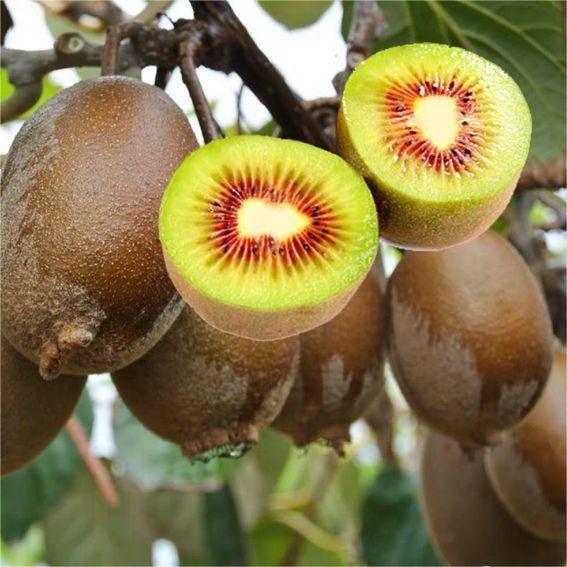著者紹介:
執筆者:安徽富陽 金峰 ECOAGRICULTURE CO.,LTD. は、園芸の専門知識と最高品質の植物や樹木が出会う場所です。30 年以上の経験を持つ当社は、園芸のあらゆるニーズに応える最高級の植物を提供する専門家としての評判を築いてきました。数基の小さなプラスチック温室から始まった当社は、約 300 エーカーに及ぶ広大な事業に成長しました。

キウイフルーツは、鮮やかな緑色の果肉と甘酸っぱい味で、どんな果樹園にもぴったりの野菜です。経験豊富な園芸家でも初心者でも、キウイフルーツを育てるのはやりがいのある楽しい経験になります。
-
品種の選択:
キウイフルーツの栽培を始める前に、気候や好みに合った品種を選ぶことが重要です。キウイフルーツには、ファジーキウイフルーツ (Actinidia deliciosa) とスムースキウイフルーツ (Actinidia chinensis) の 2 つの主な種類があります。ファジーキウイフルーツは最も一般的な種類で、スムースキウイフルーツはより甘い味と滑らかな食感で知られています。
-
植付:
キウイフルーツのつるは、有機物が豊富で水はけのよい土壌でよく育ちます。春、最後の霜が降り終わった後に、日当たりのよい場所に植えます。土壌の pH 値は 5.5 ~ 7.5 である必要があります。土壌が酸性すぎる場合は、石灰を加えて pH 値を上げることができます。丈夫なトレリス システムにつるを植え、約 10 フィートの間隔を空けます。
-
水やり:
キウイフルーツのつるは、特に成長期には定期的な水やりが必要です。キウイフルーツは湿った土壌を好みますが、水が溜まっていると耐えられません。根が深く成長するように、たっぷりと、そして頻繁に水やりをしてください。植物の根元にマルチングをすると、水分が保たれ、雑草の成長を抑えることができます。
-
施肥:
豊作を確実にするために、 キウイフルーツのつる 定期的な施肥が必要です。生育期には、10-10-10 または 20-20-20 などのバランスのとれた肥料を 4 ~ 6 週間ごとに施します。施肥量については製造元の指示に従ってください。また、植え付け前に堆肥などの有機物を土壌に混ぜておくと、長期的な栄養効果が得られます。
-
剪定:
剪定はキウイフルーツのつるの健康と生産性を維持するために不可欠です。冬季の剪定は、つるが休眠している間に、枯れた木や病気の木を取り除き、密集した枝を間引いて、つるの形を整えます。夏季の剪定は、過度の成長を抑制し、エネルギーを果実の生産に向け直し、つるの大きさと形を維持することに重点を置きます。

-
受粉:
キウイフルーツは雌雄異株で、雄株と雌株が別々に存在します。果実の実りを確実にするには、受粉のために雄株と雌株の両方を近くに植えることが重要です。キウイフルーツの品種の中には自家受粉するものもありますが、近くに雄株があると果実の実りと収穫量を増やすことができます。
-
害虫および病気の管理:
他の果物作物と同様に、 キウイフルーツ 害虫や病気に弱いです。一般的な害虫には、アブラムシ、ダニ、カイガラムシ、毛虫などがあります。定期的な監視、早期発見、総合的病害虫管理 (IPM) の実践により、害虫を効果的に防除できます。細菌性潰瘍、うどんこ病、根腐れなどの病気は、適切な衛生管理、病気に強い品種、必要に応じて殺菌剤を適切に使用することで管理できます。
-
収穫と保管:
キウイフルーツは、通常、果実が完全に熟す秋の 9 月から 11 月に収穫されます。果実は固いですが、軽く押すと柔らかくなります。収穫が早すぎると、果実が十分に熟さない場合があります。収穫後、キウイフルーツは涼しく乾燥した場所に数週間保存できます。ただし、最も新鮮な風味と食感を楽しむには、できるだけ早く食べるのが最善です。
結論:
キウイフルーツの栽培には、細心の注意と適切な管理が必要ですが、適切な技術があれば、おいしい果物を豊富に収穫できます。適切な品種の選択から、最適な栽培条件の提供、適切な剪定技術の実践、害虫や病気の防除対策の実施まで、キウイフルーツの栽培は成功への道が開けます。お住まいの地域の気候に合わせて栽培方法を調整し、地元の専門家にアドバイスを求めてさらにサポートを受けることを忘れないでください。キウイフルーツ栽培を楽しんでください!
